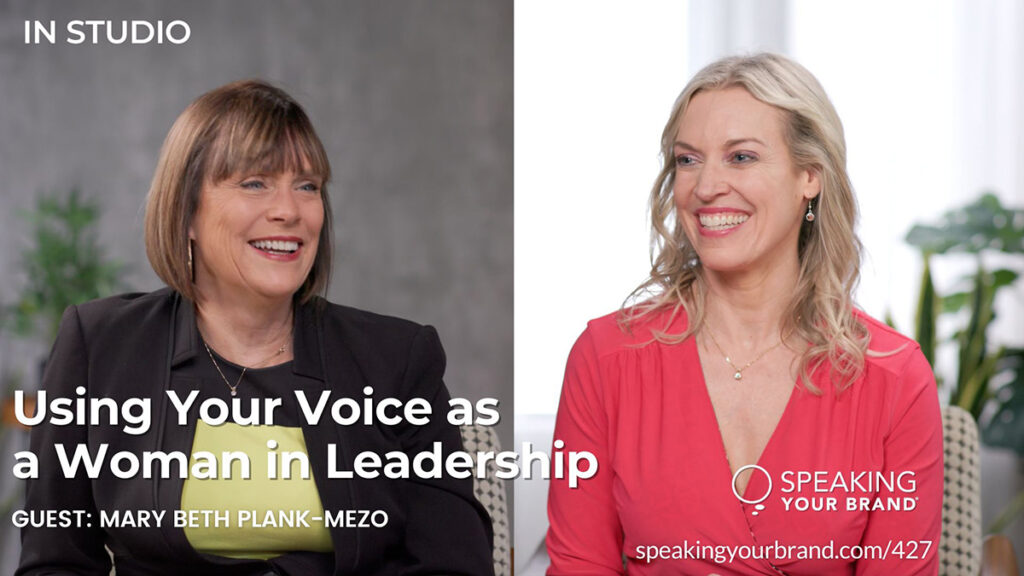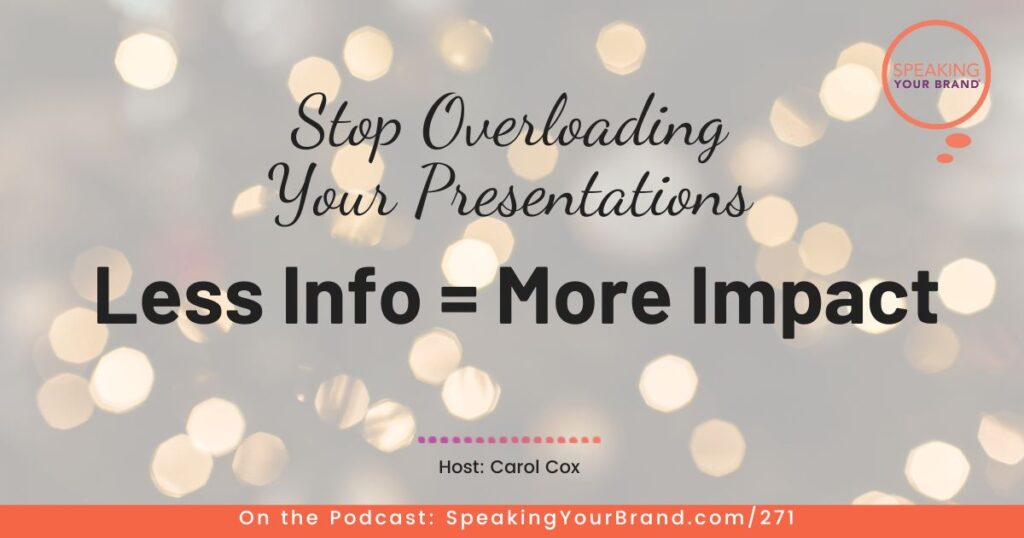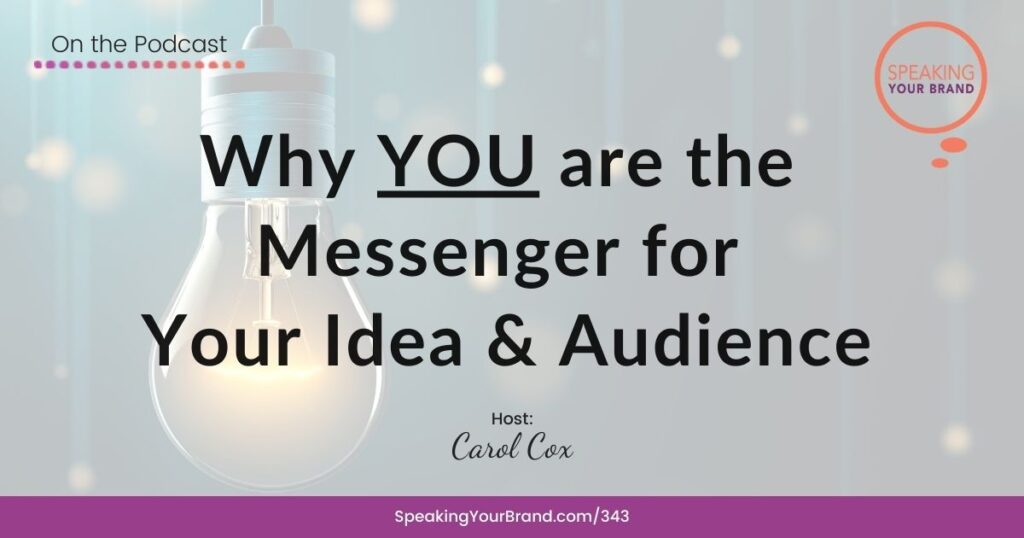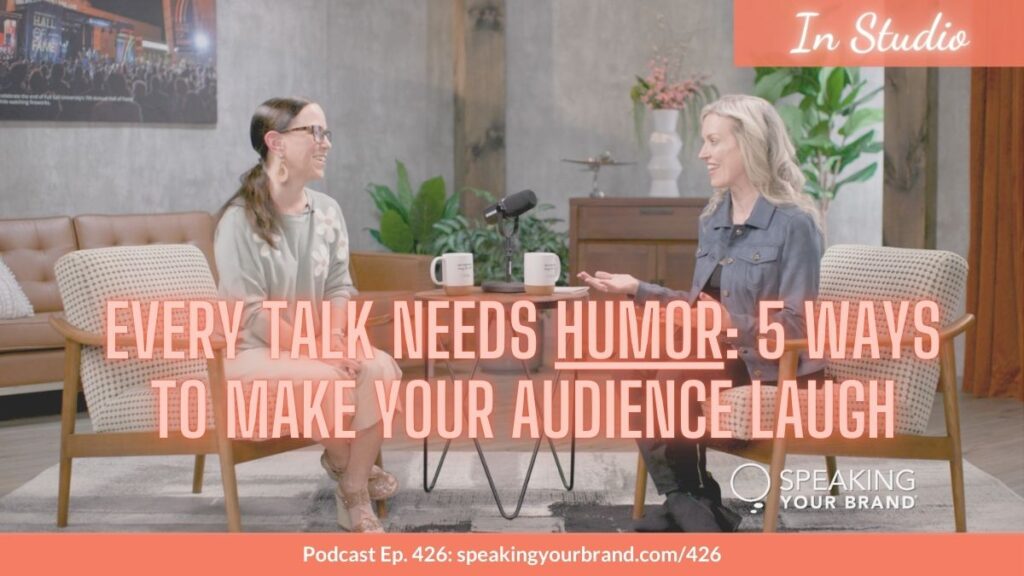The Four Layers of Thought Leadership with Carol Cox: Podcast Ep. 262
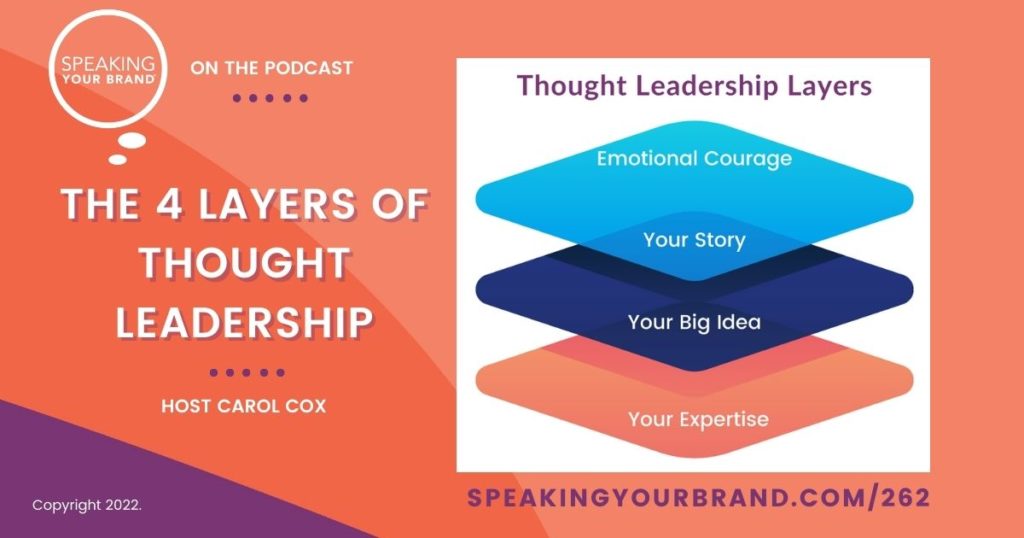
Subscribe to the podcast!
I remember last year I was doing some research and I googled “famous thought leaders.” Guess what the results were? All men.
Now, we know there are women thought leaders: Brene Brown, Mel Robbins, Nikole Hannah-Jones, Minda Harts all come to mind.
But, Google hasn’t caught on yet. Why not? Because we need MORE women thought leaders to flood the zone.
This is where you come in and this is why I’ve been talking a lot on the podcast about thought leadership and the role it plays in your business and for you getting bigger opportunities and the impact you want to have.
It’s also why I created our Thought Leader Academy – to give women entrepreneurs and professionals a place where they can develop their thought leadership ideas and signature talks.
In this episode, I’m going to talk about 4 key layers that make up thought leadership. These are layers I’ve identified as I’ve worked with our clients over the years on their keynotes, TEDx talks, and thought leadership messages and as I’ve worked on my own.
Download our FREE workbook on how to position yourself as a thought leader: https://www.speakingyourbrand.com/guide/.
About Us: The Speaking Your Brand podcast is hosted by Carol Cox. At Speaking Your Brand, we help women entrepreneurs and professionals clarify their brand message and story, create their signature talks, and develop their thought leadership platforms. Our mission is to get more women in positions of influence and power because it’s through women’s stories, voices, and visibility that we challenge the status quo and change existing systems. Check out our coaching programs at https://www.speakingyourbrand.com.
Links:
Show notes at https://www.speakingyourbrand.com/262
Download our FREE workbook on how to position yourself as a thought leader: https://www.speakingyourbrand.com/guide/.
Apply for our Thought Leader Academy: https://www.speakingyourbrand.com/academy/
Schedule a consult call with us to talk about creating your signature talk and thought leadership platform: https://www.speakingyourbrand.com/contact.
Connect with Carol on LinkedIn = https://www.linkedin.com/in/carolcox
Books mentioned:
- The Signature of All Things: A Novel by Elizabeth Gilbert
- Big Magic: Creative Living Beyond Fear by Elizabeth Gilbert
- KLF: Chaos Magic Music Money by JMR Higgs
- Podcast: A mind-bending, reality-warping conversation with John Higgs
Related Podcast Episodes:
- Episode 241: The Expert Trap: What Holds Women Back from Thought Leadership with Carol Cox
- Episode 259: Connecting Your Business and Your Thought Leadership with Carol Cox
262-SYB-4-Layers-of-Thought-Leadership.mp3: Audio automatically transcribed by Sonix
262-SYB-4-Layers-of-Thought-Leadership.mp3: this mp3 audio file was automatically transcribed by Sonix with the best speech-to-text algorithms. This transcript may contain errors.
Carol Cox:
You need these four layers for thought leadership, find out what they are and how you can start working on them on this episode of the Speaking Your Brand podcast. More and more women are making an impact by starting businesses running for office and speaking up for what matters. With my background as a TV political analyst, entrepreneur and speaker, I interview a coach purpose driven women to shape their brands, grow their companies and become recognized as influencers in their field. This is Speaking Your Brand, your place to learn how to persuasively communicate your message to your audience. Hi there, and welcome to the Speaking Your Brand podcast. I’m your host, Carol Cox. I remember last year I was doing some research and I Googled famous thought leaders because I wanted to find some women thought leaders to include. And I think it was probably a podcast episode that I was doing last summer. So I put in the term famous thought leaders and guess what the results were? They were all men. And specifically, they were all white men. Now, you know, and I know that there are women thought leaders out there, the ones that pop to mind right away, who are current thought leaders Brian Brown, Mel Robbins, Nikole Hannah-Jones, Minda Harts, all those women come to mind. But apparently, Google hasn’t caught on yet. And why not? Because we need more women thought leaders to flood the zone. There are some women thought leaders out there, but we need more and more of them there so that Google and the rest of us start paying attention.
Carol Cox:
And so this is where you come in, and this is why I’ve been talking a lot on the podcast about thought leadership and the role it plays in your business and for you getting bigger opportunities and the bigger impact you want to have. It’s also why I created our Thought Leader Academy to give women entrepreneurs and professionals a place where they can develop their thought, leadership ideas and their signature talks. In this episode, I’m going to talk about four key layers that make up thought leadership. These are layers I’ve identified as I’ve worked with our clients over the years on their keynotes, their TED talks and thought leadership messages and as I’ve worked on my own. Now there is a free workbook that you can download that will give you a recap of these layers that I’m going to go through. There’s also a couple of pages of question prompts for you to start thinking about your own thought leadership message. You can get this free workbook by going to Speaking Your Brand guide again. That’s Speaking Your Brand guide. Now let’s get into what these four layers are, so I’ll give you the four layers and then we’re going to talk about each one individually. So if you kind of think of like a stack like a stack of pancakes, the bottom pancake stack is your expertise. This is your foundation.
Carol Cox:
Layered on top of that is your big idea layer. On top of that is your personal story, your personal journey and then very top layer is the emotional courage to share it. So let’s start with layer number one, which is your expertise. That’s the foundation. So this is what you do in your business, the work that you do with your clients, your industry, your area of expertise. It could be related to degrees or credentials that you also have that align with what you do in your business. If someone asked you to do a training related to what you help your clients with, what would that training be about? That’s most likely your area of expertise. For example, my area of expertise is public speaking, creating compelling presentations, using storytelling and business. This is what we help our clients with. These are trainings we provide to companies, and these are sessions that I’ve taught at conferences over the years. The reason that I start the layer with your expertise is because your thought leadership should be connected to your area of expertise for two main reasons. The first is that you have credibility in your area of expertise. So if you already have credibility there because of the long track record that you have, and that’s just going to add to your thought leadership. The second reason that they should be connected is that you want your thought leadership to be connected to your business so that your business benefits from your thought leadership as well.
Carol Cox:
They really go hand in hand and they can reinforce each other. If you haven’t yet, listen to the episode I did three weeks ago is episode number two. Fifty nine on connecting your business and your thought leadership, I go through and give you some examples of how that works, and I really see your business message and your thought leadership message as like parallel tracks like parallel railroad tracks that align with each other and reinforce each other. So that’s your layer one, your expertise. And here’s the thing most speakers and most entrepreneurs stop here. They’re what I call expert presenters, and this is where they and where potentially you can get stuck and what I call the expert trap. And I did an episode on this last year in Twenty Twenty One called the Expert Trap. There’s a link in the show notes to go find that episode because to be a thought leader, you need to move beyond just talking and teaching about your area of expertise. The next layer you need is your big idea. Layer number two is your. Big idea, what exactly is a big idea? Big ideas come from noticing patterns, connecting the dots and then seeing what’s missing and looking deeper. I also like to think of a big idea as looking at intersections or angles of different ideas. And so a big idea isn’t just a bunch of facts or information, so you’re not teaching tactics or strategies in your thought leadership content.
Carol Cox:
Rather, a big idea is I hypothesis that you have a way of looking at things that you have. The way things are and the way things should be a big idea gives your audience a way to see things from a new perspective. It’s like you’re helping them shift their mental model of what they thought things were into, how they really are or how they could be. You’re helping them with a paradigm shift. And usually this comes about because you yourself have a paradigm shift or a change in a mental model of how you saw the world. And the reason that there’s A. big in front of ideas, it’s not just an idea, is that I like for you to think about a big idea in the sense that something that’s going to impact your industry impact the the work that you do and this goes back to your area of expertise. What is something that’s going on in your industry or or the work that you do where you see that there are gaps or there’s something missing or there’s something deeper that could be changed for the better? And where are those intersections of the different things that you’re interested in? You have experience in where you could find where these potential new connections or new ideas are. And also a big idea is useful. It contributes value to your industry and to your audiences. A lot of times I see women speakers who shy away from thought leadership content and from big idea content in their presentations because they feel like it doesn’t quote provide value to their audience because they’re not teaching them a certain thing.
Carol Cox:
Like, Here’s a step by step five things that you can do to achieve the certain outcome. And there’s definitely a time and place for teaching and training for paid workshops and paid corporate trainings and things like that that you do. Absolutely. But I want you to start stretching yourself and thinking about these big ideas, and those big ideas can contribute as much value to your audiences and even more value to your audiences than just the regular teaching and training content. So here are some examples of big ideas. So here’s like really big ideas. Joseph Campbell, you’ve heard me talk about him on the podcast before. If you’ve heard of the hero’s journey, he is the academic, the researcher who came up with this idea of the hero’s journey from looking at all of these stories and myths that different peoples and cultures have told over time. So that’s definitely a big idea. The hero’s journey now there have been criticisms of the hero’s journey that is very male centric and things and western centric. So for sure, the hero’s journey is not perfect, but it’s a big idea that was put out there and look at how much has come from this one idea of the hero’s journey.
Carol Cox:
And now people can iterate on it. People can criticize it. People can take it and then do other things with it. If you’ve watched TED talks, you are familiar with big ideas because that’s really what the central component of a great TED talk is is a big idea. If you think about Brené Brown and the TED talks that she has done, and her big idea was that vulnerability allows for connection and intimacy, and that shame blocks connection intimacy. That was her big idea. And look at how much her career has taken off because of her big idea that she put out there. One of my clients, Tammy Lally, when she did her Ted Orlando talk back in 2017, her big idea was around money. Shame. So Bernie Brown talks a lot about shame and vulnerability, and Tammy took it one step further and related it to money. Shame. If we look at scientists and researchers in the past, like Charles Darwin with the theory of natural selection, I mean, that was a big idea when that came out in back in the 1860s. And the reason that I bring him up is because one of my favorite books by Elizabeth Gilbert, the author, is one of her novels called The Signature of All Things. You probably know Elizabeth Gilbert from Eat, Pray, Love. If you have not yet read her novel The Signature of All Things, I highly recommend it. Very strong female protagonist. And in the novel The Central Woman in the novel, she lives in the early to mid part of the 1800s, and she is a botanist herself, very much like Charles Darwin, and she comes up with this theory of natural selection as well.
Carol Cox:
But because she’s a woman and she doesn’t have the same access to publications and resources as someone like Charles Darwin has, she’s not able to put this theory out there before he does. So it’s a it’s a cool novel by Elizabeth Gilbert, and that’s the that’s the power of big ideas. And if we think about my. Own thought leadership and big ideas, so I’ve been talking a lot on this podcast about the expert trap, how as women we tend, we can get stuck in the expert trap because of thinking that we need to provide teaching and training to our audiences. That’s where their value is, that that’s where our audiences expect of us and that we identify very much as the expert. And there’s a lot of social conditioning that goes into that. And so I’m putting this content out there. I’m iterating in real time, putting my ideas out there, getting feedback, and that’s what I want you to do, as well as you start working on your own big ideas. Movements are also big ideas. Think of Black Lives Matter. The MeToo movement. All of those centered around a big idea. Here’s what I want you to do. You probably have a lot of ideas swirling around in your head, in your journals and your Google Docs.
Carol Cox:
I want you to pick an idea and go with it, see where it takes you, and you can always come back and pick up one of your other ideas. If the first one that you pick just doesn’t have enough legs on it or ends up not being the direction that you want to go in. If you’ve been stuck for a while in your journal, in your Google Docs, I highly recommend finding someone to literally talk out loud your ideas to. I believe that it’s this articulating things out loud that is going to help you to develop your idea in a way that you can’t just solely in your own head. And this is my own big idea related to my thought leadership message is that when women speak in public, so literally public speaking, that is the way that we can advance women’s leadership and gender equality when women have access to the public sphere and specifically safe access to the public sphere. Whether that means on stages in the media and even on social media, that’s what we’re going to start seeing more women’s voices, women’s presences and then hopefully get to gender equality. And this is why in our programs, like our Thought Leader Academy, we have live weekly group calls and one on one coaching calls to get our clients talking, sharing, listening and iterating through their ideas. Now, the other book that I love by Elizabeth Gilbert is Big Magic.
Carol Cox:
This is a non-fiction book, and I have a couple of quotes that I pulled from this book to share with you that I thought would would help you with thinking about your big idea. Elizabeth Gilbert wrote Ideas are driven by a single impulse to be made manifest, and the only way an idea can be made manifest in our world is through collaboration with a human partner. And she talks about this quite a bit in this book, Big Magic, that their ideas kind of like swirling around and they find a home within a particular person. And then it’s up to you. If that idea finds a home in you, then it’s up to you to make that idea manifest. Whether it’s through public speaking, writing a book, creating a piece of art, creating a piece of music, whatever that happens to look like, it is up to you to make real, to make tangible that idea. If not, that idea will leave you and go to someone else. So I really want you to sit with that for a moment. What would it feel like to have an idea come to you? And then you don’t do anything with it. And then it leaves you and find someone else. That may be a good thing. Maybe then it makes room for another idea to make its home in you. Or maybe you should have acted on that idea when it came to you.
Carol Cox:
So if you have an idea right now that is kind of sitting on your heart or in your gut, but is making you maybe a little bit hesitant, a little bit uncomfortable, a little bit scared. I want you to work with that and to again find someone to talk your idea out with. There’s another book that I read a couple of years ago. Now this is a very odd book. If you’re an avid reader like I am and you like fascinating books, interesting books that draw connections and intersections in ways that you would never have expected, then pick up this book. It’s by an author named John Higgs. I originally heard him on a podcast. I’ll see if I can dig up that podcast episode. I heard him on and put him on the show notes for this episode here. And the book is called KLIF Chaos, Magic, Music, Money Again, KLIF Chaos Magic Music Money. Klif was a band in the late 80s early 90s that originated out of England, and they had a couple of hits. Three a.m. Eternal is one of their hits, and if you grew up during that time, like I did, you probably recognize the song if you heard it in the video, they decided at some point after they got really popular that they just didn’t want to be in the music industry anymore because it just wasn’t. I don’t know. They just didn’t like the fame and they didn’t like the values that they were becoming.
Carol Cox:
So they decided to take a million pounds of money like a, you know, British pounds and million and go and burn it off in some remote location in Great Britain. And it’s just a really weird story. So the author uses this really weird story to talk about ideas and just like what Elizabeth Gilbert talks about in Big Magic. He sees that ideas are out there and that they look for someone to to manifest them, and that ideas are contagious. And we can see this like with movements around the world, whether they’re for good or for bad, like we can see like ideas kind of spreading from place to place and from person to person. And so that’s why I find ideas fascinating and I really want you to think about. And this is where also reading a lot of different materials, listening to different types of podcasts will really help you to kind find these intersections and find these interesting angles. So that was the second layer of thought leadership, your big idea, but your thought leadership doesn’t stop there. And this is where a lot of people stop, so they have their area of expertise, then they have their big idea and then they just kind of put it out there. The problem was stopping there at layer two is that you’re missing the emotional connection with your audience, and this is where layer number three comes in, which is your personal story, your personal journey, your lived experience.
Carol Cox:
And this is what really starts to separate experts from thought leaders. This is what separates those TED talks and TED talks that kind of get some views versus the ones that go viral and rack up millions of views is adding in your lived experience. Now you may have one big story a one experience, one situation that happened to you that you know clearly that’s your story. Or if you’re like me, you may have a few different stories over time where you can see the thread that connects them, but there’s not like one big one that stands out. And again, you could have like a big traumatic story or little PT traumatic story or no traumatic story at all. Really, what I want you to think about is what was your journey of discovery to your big idea? Why does your big idea matter to you specifically? This is where layer number three, your personal journey, your lived experience becomes so important. There are lots of ideas out there, but why does the one that you’re interested in interest you so much? There’s a thread there that goes back, probably since you were young or at least teenager up until what you do today. And this is what I recognize not so long ago that the work that I do here and Speaking Your Brand, providing this place for women to come together to have a safe place, to explore their ideas, to work on their signature talks, to put themselves out there as a public presence and a public voice, and to have the support in the community and the guidance and the coaching to do that is exactly what I needed.
Carol Cox:
Back earlier in my career. So that was my journey of discovery to this idea of how do we advance women in leadership and how do we advance gender equality? And I see this with our clients. I see this with the speakers who spoke at our table beyond live virtual summits. The reason they came to their big idea was because they had a personal experience again, whether it was big, traumatic, little traumatic or not traumatic at all, that drew them to their idea. The common thread here, though, is that even if it’s not a traumatic experience, there are some kind of struggle. There’s some kind of loss, either a big loss or a small loss. Something that happened to you that impacted you and what did that experience teach you and how did you change because of that experience? So that’s layer number three now, layer number four is emotional courage. And that’s the vulnerability and the courage to be open with that part of your personal story, your personal journey. And when I work with our clients, we talk about what their stories are and they tell me. And then I ask them to go even deeper and it takes time to do this and also takes building trust.
Carol Cox:
This is why we do weekly calls and our Thought Leader Academy. We do the one on one coaching calls because we know it takes some time to build trust with the women in the group and then with with us as coaches, with the women. And so we keep encouraging them and helping them to dig deeper. So if you think about back to the year number three, your personal story, your personal journey, what’s something you wouldn’t want others to know about you or what’s something you wouldn’t want others to know about? Something that happened at some point in your life could be when you’re younger could be adulthood. When I gave a keynote address back in September of twenty twenty one, I shared a professional experience that had happened to me. That was a loss, and it was not something that I necessarily was proud of. As I said in the talk, which I’ll probably bring the keynote to this podcast at some point in the not too distant future, so I can share more of it with you. But I recognize that at the time this, this, this backlash that would happen because I was a woman with a public presence and a public voice at the time and got the criticism and the backlash. And as I said in my keynote, you know, I like to tell you all that I was this empowered woman and decided to, you know, stand my ground and to fight for what I wanted.
Carol Cox:
But I didn’t. I decided just not to run for re-election and the kind of just go back to running my business and then I’m proud of. It’s not something that I particularly enjoy sharing, but I know that there there are so many lessons in there for myself and for the audience. So I really want you to think about what’s something that you wouldn’t want others to know about you that you feel like could help you to connect with them regarding your thought leadership message. This is where growth happens for you, and this is where a true connection with your audience happens, and it’s tempting to go superficial with your personal story. So I really invite you to dig deeper to a place that feels uncomfortable, that you’re not really sure other people will react to it. I promise, though, that when they hear you share your story, they’re going to be thinking about themselves and about the emotions you felt and the lessons you learn relate to something that has happened in their life that are along those same lines. So they will be incredibly grateful for you for having the courage to do that. So as a recap, those four layers for thought leadership are your expertise, your big idea, your personal story, and then the emotional courage to share it. Hopefully, this episode has given you some guidance on how to think about your thought leadership message.
Carol Cox:
As I said earlier, it’s not easy to do this on your own. This is why I created our Thought Leader Academy so safe learning container for you to connect with other women just like you who are seeking to move from experts to thought leaders. It’s a place to wrestle with your ideas, to connect your ideas to your stories and to be real and vulnerable. And if you’ve thought, I don’t know, my big idea is I don’t really have a compelling personal story you do. It is in there. I used to think the same thing because I don’t have one big event that happened to me, but we all we all have is a thread of experiences that have led to our worldview. And so it it’s our role as coaches to help you find this thread that connects to your big idea and your personal journey. If you’d like to join us, the first step is to submit your application for the Thought Leader Academy. We then follow up with the Zoom call to talk about your goals and to make sure that it’s the right fit for you. You can get all the details and submit your application as Speaking Your Brand academy. Again, that’s Speaking Your Brand academy. If you enjoyed this episode, I would love it for you to share it with a friend or a colleague and also shared on social media and tag me. You can find me on LinkedIn and Instagram. Until next time. Thanks for listening.
Sonix is the world’s most advanced automated transcription, translation, and subtitling platform. Fast, accurate, and affordable.
Automatically convert your mp3 files to text (txt file), Microsoft Word (docx file), and SubRip Subtitle (srt file) in minutes.
Sonix has many features that you’d love including transcribe multiple languages, automated translation, powerful integrations and APIs, automated transcription, and easily transcribe your Zoom meetings. Try Sonix for free today.



